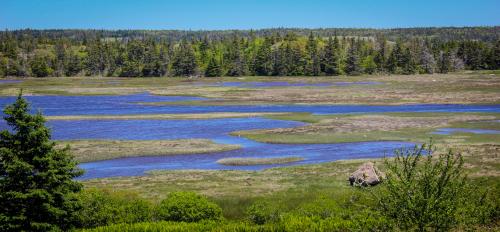
Salt Marshes - Past and Present
People have been using and benefiting from salt marshes for hundreds of years. Before the arrival of Europeans, the First Nations, especially the Mi'kmaq, gathered shellfish from the marshes. In areas where they camped thousands of years ago, this is evidenced by the piles of shellfish remains, such as periwinkles, which have been found there.
Today people visit salt marshes and adjacent mudflats for recreational purposes such as nature study, clam digging, hunting, and fishing.
Many plants of the salt marshes are still used today. The Acadians collect the Seaside-Plantain.
Formation
A salt marsh is the result of the interaction between living organisms and the natural forces of wind, currents, storms, tides, and salt.
Physical Characteristics
Ice
In winter, ice covers much of the salt marsh. It protects the marsh from changing conditions. During ice break-up in spring, chunks of salt marshes may be carried away to other coastal ecosystems. Marsh grasses are often trimmed to the ground by the action of 'ice trimming.'
Salt
With the daily movement of the tides, salinity constantly changes. Saltwater mixes with freshwater from rivers, streams, rain-water and melting snow. When the saltwater is diluted with freshwater, it is called brackish.
Tides
Tides can cause erosion. They bring in and carry off organic material and nutrients. Gales and storm tides also cause erosion and remove sediments and plants. Shorebirds feed during low tide and roost during high tide.
Animals and plants that live in the salt marsh reap the benefits of an ecosystem that has plenty of food to offer. They have adapted to the changing salinity, the warm water, and the tides.
Plants
Plants are the producers of organic material, which in turn becomes food for other species, or decomposes into nutrients. Once the Salt-water Cord-grass establishes itself in a salt marsh, other salt-loving plants follow. These plants are termed halophytic and have the unique ability to excrete excess salt and/or retain water.
Birds
Shorebirds are often seen in salt marshes feeding on the mudflats. They are most numerous during migration in summer and fall. They can be seen by the thousands at low tide, feeding on invertebrate organisms in the mud.
It is also very common to see Great Blue Herons and other birds searching for food in the creeks, channels, and pannes in salt marshes. Some birds such as Black Ducks nest in salt marshes and can be seen dipping into the water for their food. Other waterfowl feed here in the fall and winter.
From mid June to early August, the common tern is frequently seen here diving into the water for food to feed their young. On occasion, one may see the arctic tern and even the “endangered” roseate tern dipping into the water for feed from this particular viewing location.